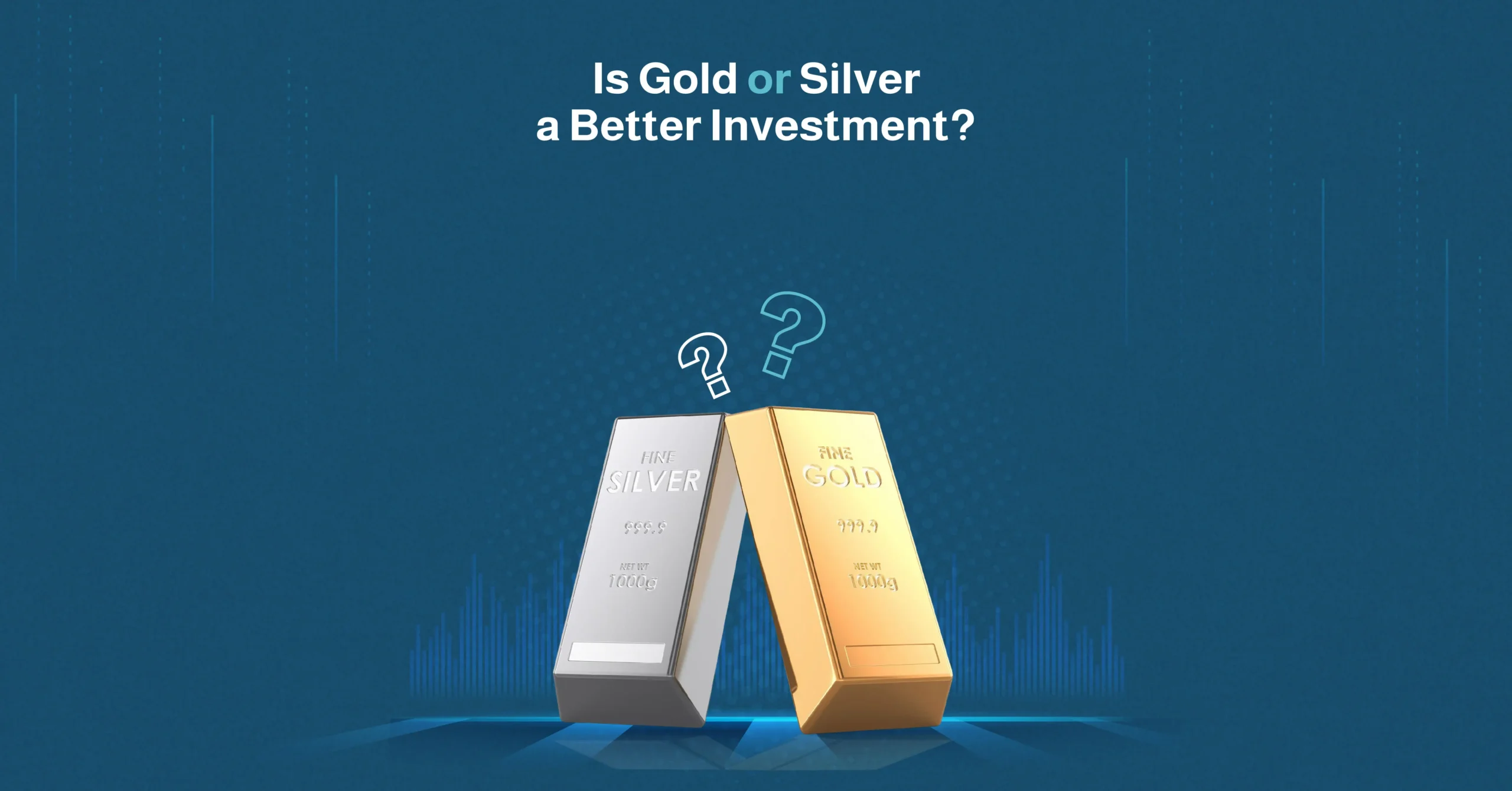It may feel to some that 2026 will be a continuation of 2025, which has been uncertain to say the least. Geopolitical shifts, slowing global growth, and even shifts in the U.S. economic policy have investors looking for options to protect their wealth. So, where do you keep your money protected from uncertainty? Stocks and bonds may still be the forerunners in many portfolios, but a growing number of investors, both in Saudi Arabia and the MENA region, are turning to precious metals as a method of protecting their wealth.
Gold and silver have been a method of holding wealth for centuries, offering refuge when markets are unpredictable or currencies weaken. Both gold and silver are tangible and universally recognized, with a history of performance in times of inflation and economic instability. While they both share the reputation of “Safe-haven” assets, each behaves differently in the market.
This is where the question arises: is gold or silver a better investment? The answer isn’t always black and white. Each metal has its strengths, weaknesses, and perfect conditions for growth. With an understanding of these differences, you will be able to make better informed decisions, should you invest in one over another, or rather invest in a combination of both.
We will be exploring the historical roles, comparing their performance and volatility, weighing the pros and cons, and seeing how they might fit into your portfolio in 2026, in combination with income-generating assets.
More topics can be read on the Gamma blog
Why Investors Turn to Gold and Silver for Wealth Protection
Gold and silver have always held a special place in civilization; they represent wealth and stability. From ancient coins to modern bullion, they have held their value across generations and economic cycles. Gold and silver, despite a changing backdrop where wealth exists in a digital space, the appeal of the physical, tangible product remains strong.
A major reason for the popularity of these metals among investors is the ability to hedge against inflation. When the cost of living rises and the purchasing power of currency decreases, gold and silver will often maintain their value. During periods of high inflation, as we saw in the US in the 1970s or the more recent inflationary spikes, both metals have retained their value and provided a form of protection.
Another aspect or factor to note is diversification. Adding gold or silver to a portfolio, heavy with stocks, bonds, and real estate, can reduce overall volatility. Precious metals often move differently from traditional asset classes; this means they can be used to help smooth out returns over time.
The next benefit that makes these precious metals appealing is liquidity, meaning it can easily be bought and sold in most global markets, from local jewellery stores to international exchanges. Meaning they are accessible to any investor regardless of location.
It is important to remember that these precious metals do not generate wealth but rather act as a wealth holding over time. They provide peace of mind during times of economic uncertainty or geopolitical instability.
Gold vs. Silver: Key Differences Every Investor Should Know
While we know that gold and silver are safe-haven assets, they behave differently in the market. These differences will determine whether gold or silver is a better investment for your portfolio.
Price and Accessibility
Gold has a higher price per ounce, making it a significant commitment for new investors. Silver’s cost is lower and allows investors to start with smaller amounts and build up more gradually.
Volatility
Gold tends to move more steadily, offering investors more stability, whereas silver can be more volatile. Silver tends to rise quickly but fall quickly too.
Industrial demand
Gold’s value is derived from demand by investors and the jewellery industry. Silver has extensive industrial uses in electronics, solar panels, and medical technology. This would mean that silver prices would fluctuate more in the global market, as it would be more sensitive to global manufacturing trends.
Storage and portability
Gold has more value for a smaller quantity when compared to silver. The same value of silver would take up more space in storage, while this may seem like a strange yet obvious point, it does need to be considered by investors who would need to deal with storage.
Comparison table: Gold vs Silver
| Features | Gold | Silver |
| Average Price/ Ounce | Higher | Lower |
| Volatility | Lower | Higher |
| Main Demand Source | Investment, jewellery | Investment, industrial use, jewellery |
| Storage Space Needed | Minimal for high value | Larger volume for same value |
| Market Stability | More stable over time | More reactive to market shifts. |
Pros and Cons of Investing in Gold
While gold is seen as the ultimate safe-haven asset, it, like any investment, is not without risk and limitations. It has had a long history of preserving wealth even during times of war, recession, and currency devaluation. If this is the investment choice you are interested in, it would be wise to consider not only the pros but the cons, too.
Pros
-
- Stability and Reliability: Gold tends to hold its value over time, which is why it is the preferred choice during financial uncertainty. It is globally recognised and traded, making investors confident in its liquidity.
- Hedge Against Inflation: Gold has a proven track record during inflation rises, helping to protect purchasing power.
- Long-term Preservation of Wealth: Gold doesn’t tarnish or corrode; it can be stored indefinitely without losing physical quality, making it an asset that can be passed down through generations.
Cons
- High Entry Costs: The high price per ounce means that it may not be accessible to all, or would be difficult for smaller investors to buy significant quantities.
- Limited Growth Potential in Strong Markets: During prosperous periods, when economies are expanding and stock markets are booming, gold’s performance may be a little lackluster, as it lags behind the riskier assets.
- No Passive income: Gold is a way to freeze wealth, as it doesn’t generate dividends or interest. The returns come solely from price appreciation, which is often slow in stable economies.
Pros and Cons of Investing in Silver
Silver is often overshadowed by its shinier counterpart, gold. Despite this, it has qualities that make it a welcome addition to any diverse portfolio. While silver may be more volatile, it offers unique opportunities, especially for those comfortable with the higher price swings.
Pros
- Affordability: Silver has a lower price per ounce, making it a more accessible option for beginner investors and for those wanting to build up their holdings without a large upfront cost gradually.
- Strong industrial demand: Silver is an important component in the manufacturing of electronics, solar panels, and medical devices. This demand can help support the price over time and may create opportunities for growth during tech booms.
- Higher Upside Potential in Bull Markets: The volatility of silver means that it may experience sharper price increases than gold would.
Cons
- Greater volatility: The price swings can be dramatic, which may unnerve some investors or those looking for more stable returns.
- Storage Challenges: Since silver has a lower price per ounce, the quantity of silver required to achieve the same value as gold is significantly greater, making physical storage more expensive or challenging.
- Less Perceived as “Safe-haven”: While silver is valuable, it lacks the global notoriety that gold has; therefore, it is not recognised as gold is for crisis protection. This would limit its appeal for some investors.
Is Gold or Silver a Better Investment for You in 2026?
The answer to the question: Is gold or silver a better investment? We would need to consider a few personal factors, such as goals, risk tolerance, and time horizon.
As an investor, if you are looking for or value stability and long-term wealth preservation, then gold would be the metal of choice for you. Gold offers lower volatility, global recognition, and proven resilience during inflation and economic uncertainty. Conservative investors often allocate a larger share of their precious metal holdings to gold for these reasons.
Silver might be more appealing to those looking for growth potential at a lower entry cost. Its industrial demand, along with the higher volatility, means investors may receive greater gains during bullish (period of rising asset prices) periods. While this all sounds positive, it also carries more risk. Growth-oriented investors might use silver to complement a small gold holding.
For most investors, the answer lies in between, meaning diversification by holding both metals in proportions that align with personal objectives. This would balance the stability of gold with silver’s potential growth, and therefore reduce the risk, while maintaining the exposure to each asset’s strengths.
While on the topic of diversification, these precious metals can also be paired with other asset classes to strengthen resilience. Gamma Assets is a great option and offers opportunities to invest in real-world, asset-backed real estate alongside precious metals. This type of combination will help investors spread risks across different markets, providing both security and potential returns. By assessing your goals, risk tolerance and time horizon you can decide whether gold, silver, or a combination is good for you and your portfolio in 2026.
While gold and silver may have different strengths and weaknesses, and the choice between them is wholly personal, the plan to invest in these precious metals as part of a diverse portfolio is still a wise one. As we have come to learn, gold is a better option for those looking for stability and preservation, while silver offers growth potential at a lower cost. A mix of both may be your plan, supported by other asset classes for balance. As long as you are investing with a clear strategy that fits your goals and long-term vision for 2026 and beyond.
You can start investing now from the Gamma Asset Investment Platform
FAQ
- Is gold a safer investment than silver?
Yes, gold is safer as it has a lower volatility and global recognition, making it more stable, especially in economic downturns. Silver can offer higher returns in certain markets but carries greater short-term swings.
- Can I invest in both gold and silver at the same time?
Yes, many investors hold both to balance gold’s stability with silver’s growth potential. Allocating proportions based on goals can provide a more resilient portfolio.
- How does inflation impact gold and silver investments?
Both metals can protect purchasing power during inflation. Gold often reacts more steadily, while silver’s industrial demand can cause sharper movements, in both directions, depending on broader economic conditions.













